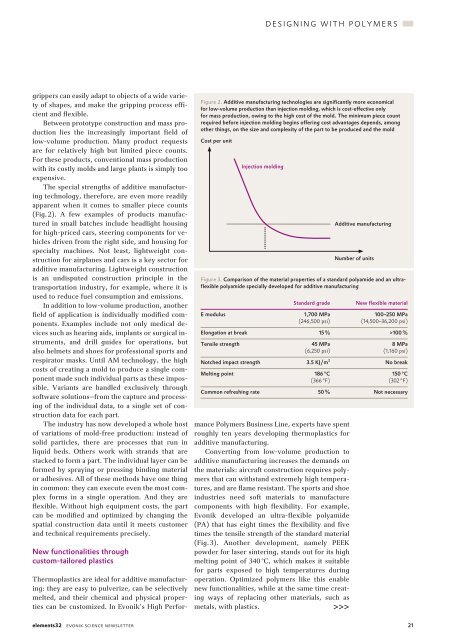Download - Evonik Industries
Download - Evonik Industries
Download - Evonik Industries
You also want an ePaper? Increase the reach of your titles
YUMPU automatically turns print PDFs into web optimized ePapers that Google loves.
grippers can easily adapt to objects of a wide variety<br />
of shapes, and make the gripping process efficient<br />
and flexible.<br />
Between prototype construction and mass production<br />
lies the increasingly important field of<br />
low-volume production. Many product requests<br />
are for relatively high but limited piece counts.<br />
For these products, conventional mass production<br />
with its costly molds and large plants is simply too<br />
expensive.<br />
The special strengths of additive manufacturing<br />
technology, therefore, are even more readily<br />
apparent when it comes to smaller piece counts<br />
(Fig. 2). A few examples of products manufactured<br />
in small batches include headlight housing<br />
for high-priced cars, steering components for vehicles<br />
driven from the right side, and housing for<br />
specialty machines. Not least, lightweight construction<br />
for airplanes and cars is a key sector for<br />
additive manufacturing. Lightweight construction<br />
is an undisputed construction principle in the<br />
trans portation industry, for example, where it is<br />
used to reduce fuel consumption and emissions.<br />
In addition to low-volume production, another<br />
field of application is individually modified components.<br />
Examples include not only medical devices<br />
such as hearing aids, implants or surgical instruments,<br />
and drill guides for operations, but<br />
also helmets and shoes for professional sports and<br />
respirator masks. Until AM technology, the high<br />
costs of creating a mold to produce a single component<br />
made such individual parts as these impossible.<br />
Variants are handled exclusively through<br />
software solutions—from the capture and processing<br />
of the individual data, to a single set of construction<br />
data for each part.<br />
The industry has now developed a whole host<br />
of variations of mold-free production: instead of<br />
solid particles, there are processes that run in<br />
liquid beds. Others work with strands that are<br />
stacked to form a part. The individual layer can be<br />
formed by spraying or pressing binding material<br />
or adhesives. All of these methods have one thing<br />
in common: they can execute even the most complex<br />
forms in a single operation. And they are<br />
flex ible. Without high equipment costs, the part<br />
can be modified and optimized by changing the<br />
spatial construction data until it meets customer<br />
and technical requirements precisely.<br />
New functionalities through<br />
custom-tailored plastics<br />
Thermoplastics are ideal for additive manufacturing:<br />
they are easy to pulverize, can be selectively<br />
melted, and their chemical and physical proper-<br />
elements32 evonik science newsletter<br />
D e S i G n i n G w i t H P o l Y M e r S<br />
Figure 2. Additive manufacturing technologies are significantly more economical<br />
for low-volume production than injection molding, which is cost-effective only<br />
for mass production, owing to the high cost of the mold. The minimum piece count<br />
required before injection molding begins offering cost advantages depends, among<br />
other things, on the size and complexity of the part to be produced and the mold<br />
Cost per unit<br />
Injection molding<br />
Figure 3. Comparison of the material properties of a standard polyamide and an ultraflexible<br />
polyamide specially developed for additive manufacturing<br />
mance Polymers Business Line, experts have spent<br />
roughly ten years developing thermoplastics for<br />
additive manufacturing.<br />
Converting from low-volume production to<br />
additive manufacturing increases the demands on<br />
the materials: aircraft construction requires polymers<br />
that can withstand extremely high temperatures,<br />
and are flame resistant. The sports and shoe<br />
industries need soft materials to manufacture<br />
components with high flexibility. For example,<br />
<strong>Evonik</strong> developed an ultra-flexible polyamide<br />
(PA) that has eight times the flexibility and five<br />
times the tensile strength of the standard material<br />
(Fig. 3). Another development, namely PEEK<br />
powder for laser sintering, stands out for its high<br />
melting point of 340 °C, which makes it suitable<br />
for parts exposed to high temperatures during<br />
operation. Optimized polymers like this enable<br />
new functionalities, while at the same time creating<br />
ways of replacing other materials, such as<br />
met als, with plastics.<br />
ties can be customized. In <strong>Evonik</strong>’s High Per for- >>><br />
Additive manufacturing<br />
Number of units<br />
Standard grade New flexible material<br />
E modulus 1,700 MPa 100–250 MPa<br />
(246,500 psi) (14,500–36,200 psi)<br />
Elongation at break 15 % >100 %<br />
Tensile strength 45 MPa 8 MPa<br />
(6,250 psi) (1,160 psi)<br />
Notched impact strength 3.5 KJ/m² No break<br />
Melting point 186 °C 150 °C<br />
(366 °F) (302 °F)<br />
Common refreshing rate 50 % Not necessary<br />
21

















